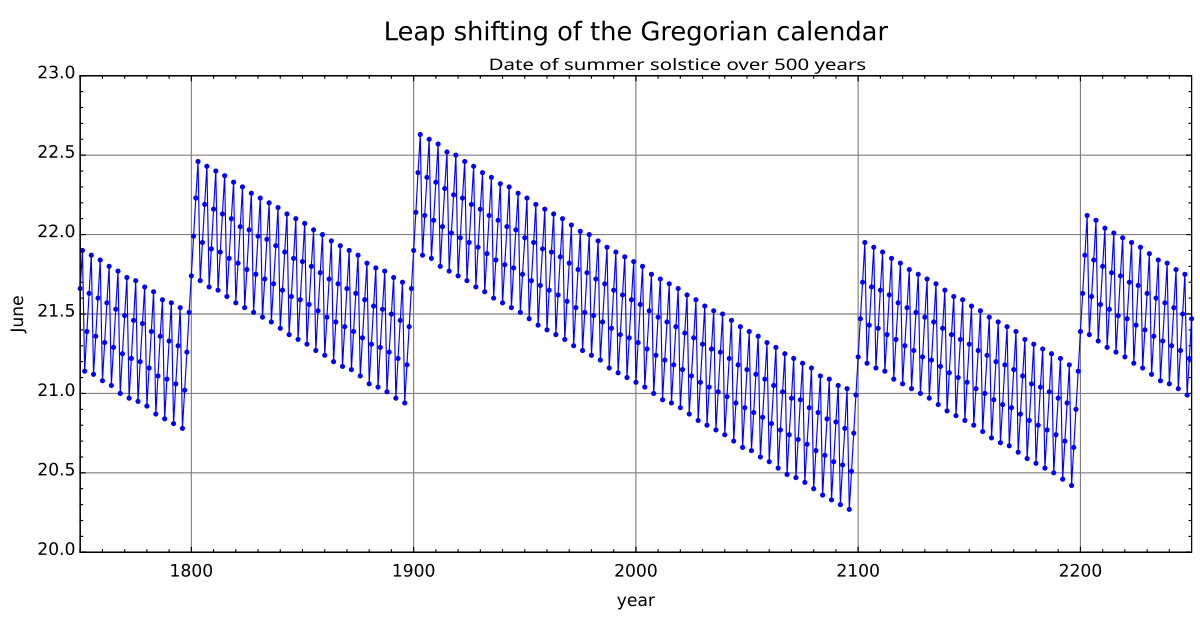cross-posted from: https://lemmy.world/post/19541930
Preferably a Holocene colander?
A consensus view was formally adopted by the IUGS in 2013, placing its start at 11,700 years before 2000 (9701 BC), about 300 years more recent than the epoch of the Holocene calendar.[6]
Some problems with Gregorian calendar
The Gregorian calendar improves the approximation made by the Julian calendar by skipping three Julian leap days in every 400 years, giving an average year of 365.2425 mean solar days long.[82] This approximation has an error of about one day per 3,030 years[s] with respect to the current value of the mean tropical year. However, because of the precession of the equinoxes, which is not constant, and the movement of the perihelion (which affects the Earth’s orbital speed) the error with respect to the astronomical vernal equinox is variable; using the average interval between vernal equinoxes near 2000 of 365.24237 days[83] implies an error closer to 1 day every 7,700 years. By any criterion, the Gregorian calendar is substantially more accurate than the 1 day in 128 years error of the Julian calendar (average year 365.25 days).
In the 19th century, Sir John Herschel proposed a modification to the Gregorian calendar with 969 leap days every 4,000 years, instead of 970 leap days that the Gregorian calendar would insert over the same period.[84] This would reduce the average year to 365.24225 days. Herschel’s proposal would make the year 4000, and multiples thereof, common instead of leap. While this modification has often been proposed since, it has never been officially adopted.[85]
On time scales of thousands of years, the Gregorian calendar falls behind the astronomical seasons. This is because the Earth’s speed of rotation is gradually slowing down, which makes each day slightly longer over time (see tidal acceleration and leap second) while the year maintains a more uniform duration.
Calendar seasonal error Gregorian calendar seasons difference
This image shows the difference between the Gregorian calendar and the astronomical seasons.
The y-axis is the date in June and the x-axis is Gregorian calendar years.
Each point is the date and time of the June solstice in that particular year. The error shifts by about a quarter of a day per year. Centurial years are ordinary years, unless they are divisible by 400, in which case they are leap years. This causes a correction in the years 1700, 1800, 1900, 2100, 2200, and 2300.
For instance, these corrections cause 23 December 1903 to be the latest December solstice, and 20 December 2096 to be the earliest solstice—about 2.35 days of variation compared with the astronomical event.
Proposed reforms The following are proposed reforms of the Gregorian calendar:
Holocene calendar
International Fixed Calendar (also called the International Perpetual calendar)
World Calendar
World Season Calendar
Leap week calendars
Pax Calendar
Symmetry454
Hanke–Henry Permanent Calendar



Also, on Earth we already have situations near the equator where there’s not really a significant change in the weather from one season to the next, or near the poles where for parts of the year days are considerably longer/shorter than elsewhere on the planet, we also have people living in scorching deserts and frozen tundras, at high altitudes with thinner atmosphere, etc. and despite all that variation we don’t really see major differences in how quickly children mature.
The differences could be even more profound on other planets of course.
There have also been studies where people have lived in caves or bunkers without natural light, clocks, or other cues about the time or day/night cycle, and it’s been found that we stay pretty close to a 24 hour circadian rhythm (usually slightly longer actually, but within a few hours of that target,) so it seems like that’s something that might be hard-coded into us. Of course those studies have been done on adults who have had decades to acclimate to a 24 hour cycle, so it’s plausible that kids raised in a different environment would naturally adapt to a different cycle, but since we’re probably not going to be sending unaccompanied minors to the stars, those same kids would probably be raised by adults who are used to a 24 hour schedule and would raise those children in the same schedule.
You might see some divergence from that over the years and multiple generations, but if there’s a 24 hour clock present, and people decide to stick to that, I suspect that would work just fine. It would probably come down to whether it’s more beneficial for people to be in sync with the rest of humanity, or to be on the local cycle. My money’s on the former, since we probably aren’t going to need to worry about hunting for sustenance or avoiding predators, or other such things that our circadian rhythms evolved for.
Something we can’t really account for though is if different gravity would affect how quickly children mature. It will almost certainly have an effect on how they mature with differences in height and muscle/bone density, but I don’t think we can really say if it will change how quickly their brains develop, when they begin puberty, etc.
There’s other factors that could play a part as well of course, the composition of the atmosphere, the intensity of radiation from the star you’re orbiting, diet, exercise, different mutations that could arise over the generations.